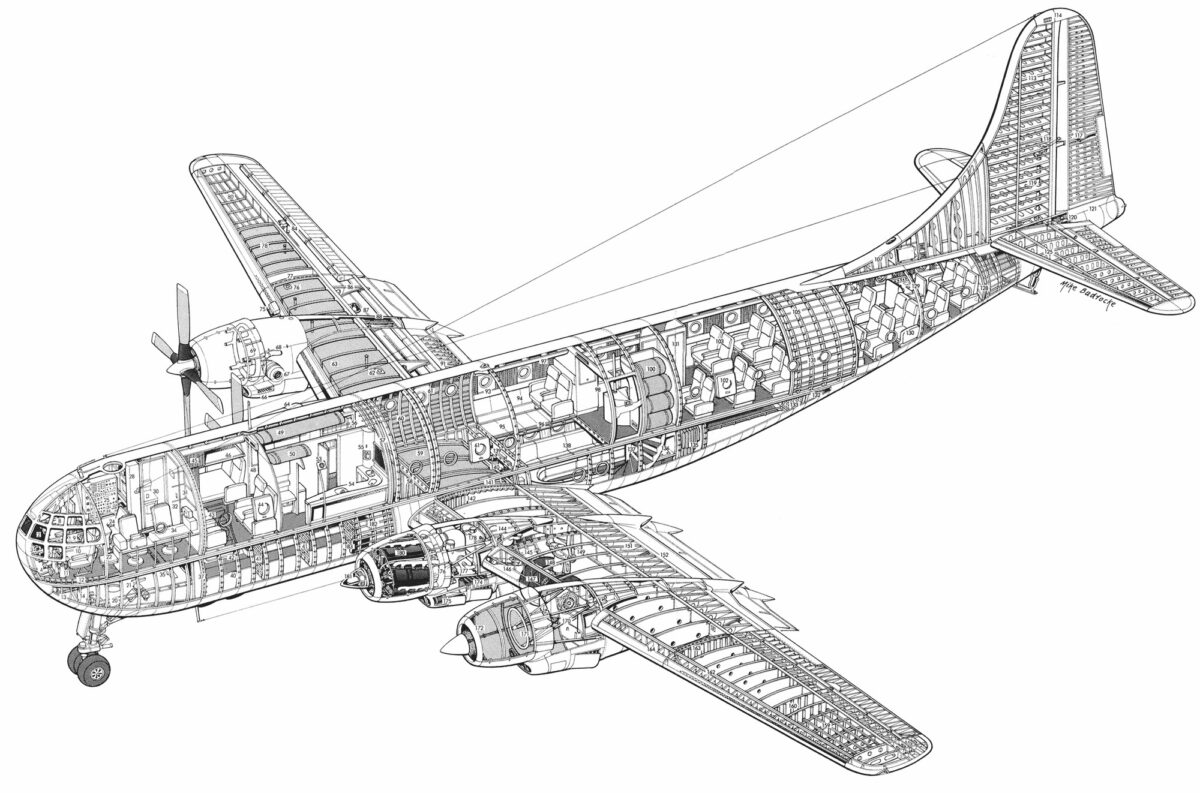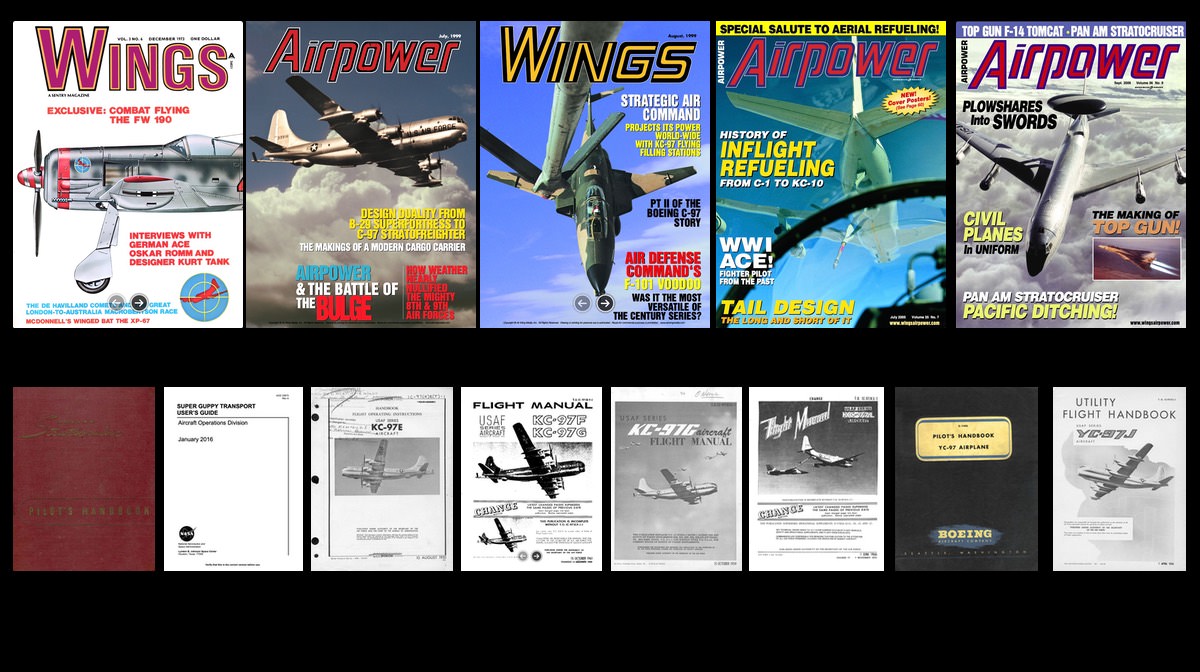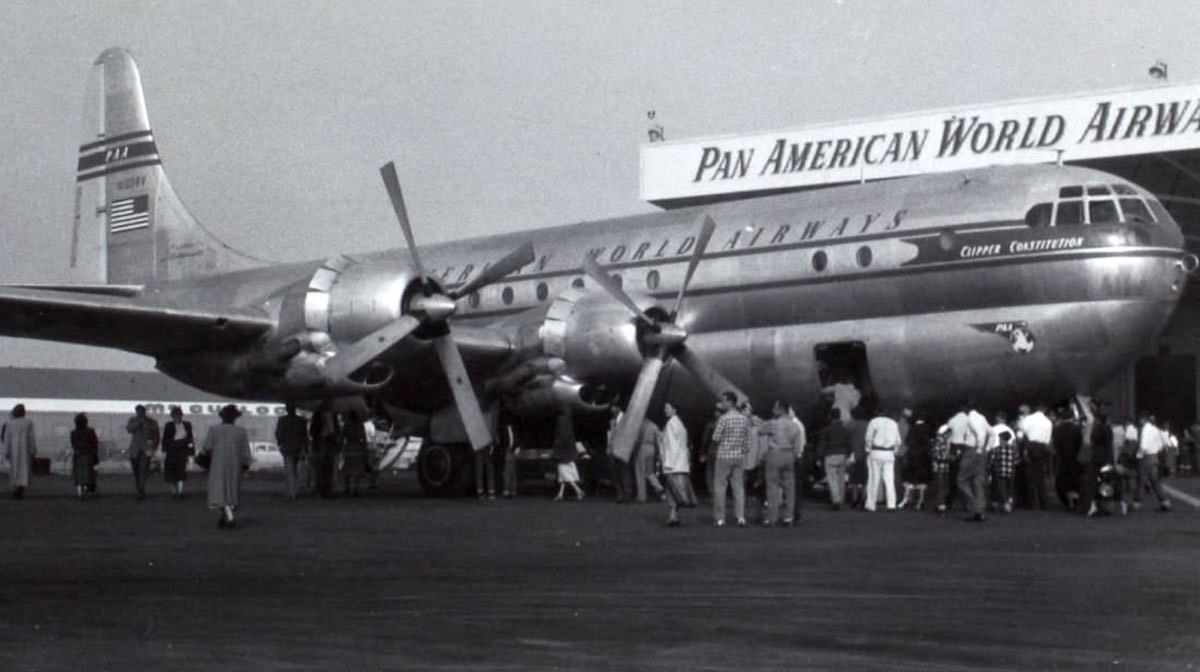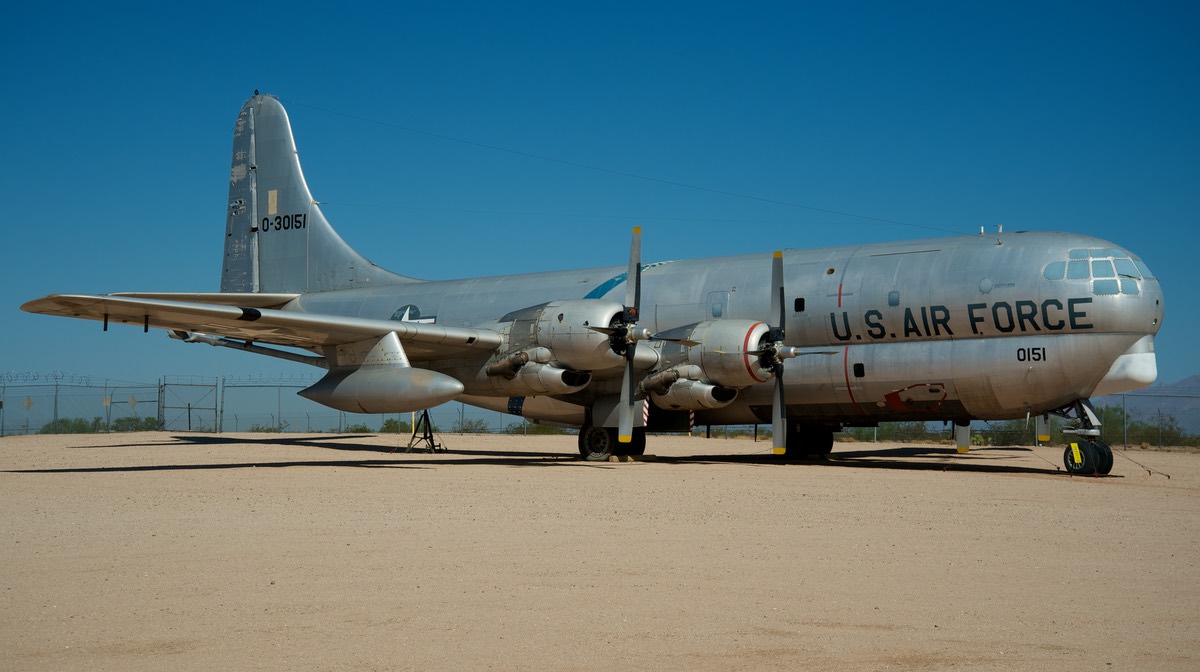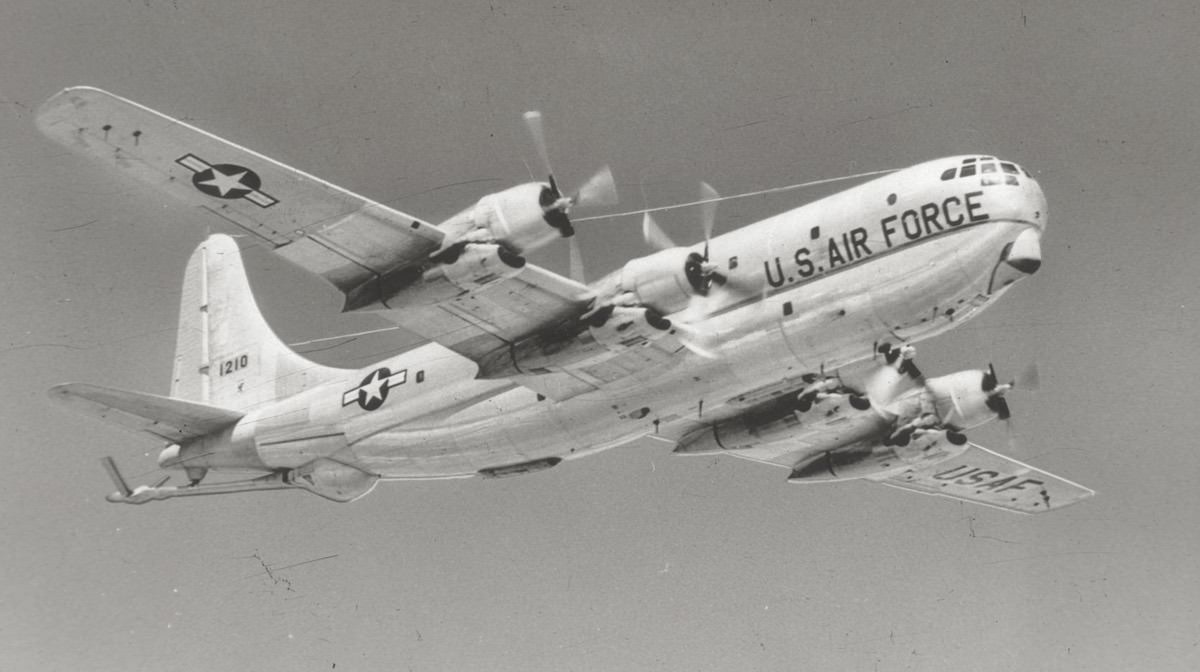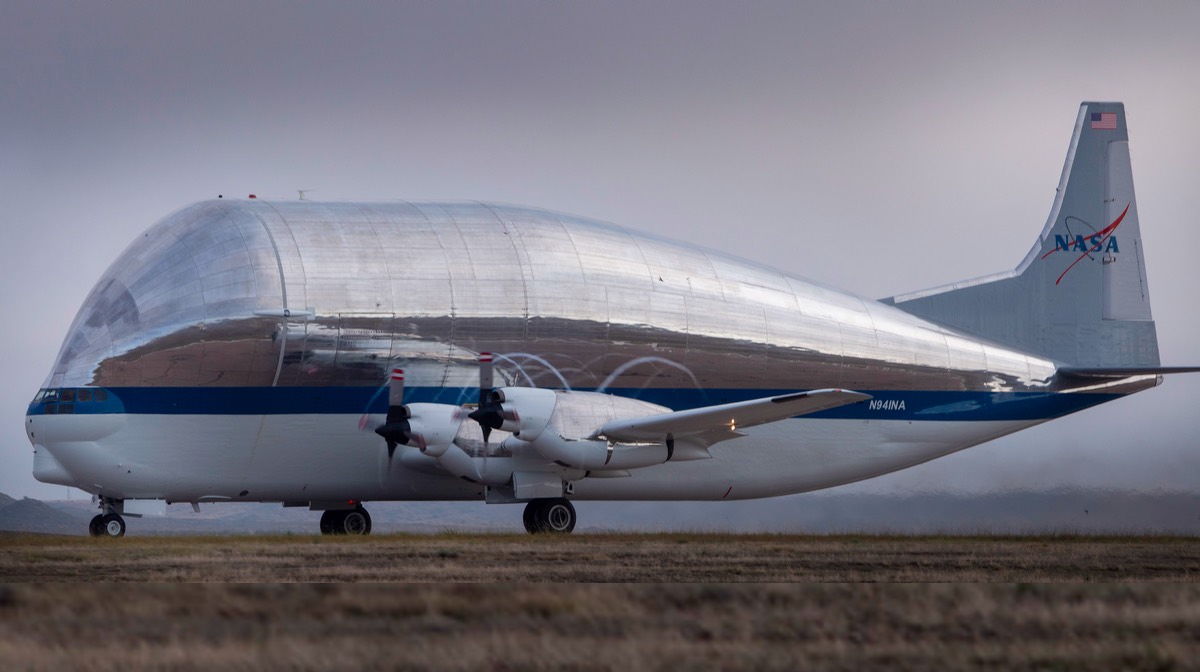Price: $29.95
- 5 magazines, 8 manuals, & photos
- PDF contains 3,164 pages
- Content is keyword searchable
- Print a personal copy
- Pay via PayPal or Credit Card
- International orders welcome!
- Download files upon payment
December 1973
- Comet, the great deHavilland racers
- The Last Sortie, the designer of the Focke-Wulf Fw-190
- “It Might Have Been Moonbat”, McDonnell’s first fighter
- Rocket Fighter, Minicraft’s Me-163 model
- Fading Away, goodbye to the KC-97
- The First Hydroplane, pioneering with Glenn Curtiss
July 1999
- Airpower & The Battle of the Bulge
- The B-29 Superfortress and C-97 Stratofreighter
August 1999
- The KC-97 Flying Filling Station
- Part II of the Boeing C-97 Story
- The Air Defense Command’s F-101 Voodoo
July 2005
- History of InFlight Refueling – From C-1 to KC-10
- WWI ACE! Fighter pilot from the past
- Tail Design – The long and short of it
September 2006
- Plowshares into swords
- Civil planes in uniform
- The making of Top Gun
- Pan Am Stratocruiser – Pacific ditching
Manuals & Photos
- Boeing 377 Stratocruiser Pilot’s Handbook, 1949
- C-97 NASA Super Guppy User’s Guide, 2016
- KC-97E Flight Manual, 1951
- KC-97F/G Flight Manual, 1962
- KC-97G Flight Manual, 1959
- KC-97L Flight Manual, 1973
- YC-97 Pilots Handbook, 1947
- YC-97J Flight Handbook, 1955
- Over 700 Photos!
Boeing 377 Stratocruiser / C-97 Stratofreighter / KC-97 Stratotanker / Super Guppy
Boeing 377
C-97 Specs
KC-97L Specs
Super Guppy
Cutaway
Videos
General Characteristics

- Crew: 4 flight crew (captain, first officer, flight engineer, navigator) + cabin crew
- Capacity: Up to 100 passengers on main deck plus 14 in lower deck lounge; typical seating for 63 or 84 passengers or 28 berthed and five seated passengers.
- Length: 110 ft 4 in (33.63 m)
- Wingspan: 141 ft 3 in (43.05 m)
- Height: 38 ft 3 in (11.66 m)
- Wing area: 1,769 sq ft (164.3 m2)
- Empty weight: 83,500 lb (37,875 kg)
- Max takeoff weight: 148,000 lb (67,132 kg)
- Powerplant: 4 × Pratt & Whitney R-4360-B6 Wasp Major 28-cylinder air-cooled radial piston engines, 3,500 hp (2,600 kW) each
- Propellers: 4-bladed constant-speed fully-feathering propellers
Performance
- Maximum speed: 375 mph (604 km/h, 326 kn)
- Cruise speed: 301 mph (484 km/h, 262 kn)
- Range: 4,200 mi (6,800 km, 3,600 nmi)
- Service ceiling: 32,000 ft (9,800 m)
Variants
- 377-1
- Proposed variant to be powered by Wright R-3350 Duplex-Cyclone engines. It was to be fitted with the flaps and deicing boots from the B-29.
- 377-6
- Proposed variant to be powered by supercharged Allison V-3420 engines.
- 377-10-19
- Prototype Stratocruiser; one built. Later brought up to 377-10-26 standard and sold to Pan American World Airways in 1950.
- 377-10-26
- Variant built for Pan American World Airways with round windows. 20 new aircraft built, plus one converted from the 377-10-19 prototype.
- 377-10-26S Super Stratocruiser
- 10 refitted with more powerful engines and a larger fuel capacity for Pan American transatlantic flights.
- 377-10-27
- Variant intended for Transcontinental & Western Air, but not built.
- 377-10-28
- Four ordered by the Scandinavian Airlines System, but taken up by BOAC after SAS canceled the order. Aircraft had circular windows and extra deluxe interior appointments, which differed with each aircraft.
- 377-10-29
- Eight delivered to American Overseas Airlines with round windows for the main cabin and rectangular windows for the lower cabin.
- 377-10-30
- Ten for Northwest Orient Airlines with all rectangular windows. The aircraft were eventually fitted with weather radomes similar to the C-97A.
- 377-10-32
- Six for the British Overseas Airways Corporation (BOAC). All cabin windows were circular.
- 377-10-34
- Seven for United Air Lines. Rectangular windows on the main cabin and circular windows on the lower cabin. Six aircraft were later sold to BOAC.
- 377-10-40
- Proposed variant for domestic flights with high-density seating. Was to be offered in a 105-seat “A” configuration or a 104-seat “B” configuration, both with only two lavatories and no galley.
- 377-11
- Proposed variant to be powered by Wright XA-395 turbine engines.
- 377-17-39
- Proposed variant for Cubana de Aviación to be powered by four Allison XT40-A-6 turboprop engines, each driving two three-bladed contra-rotating propellers. The fuselage was to be stretched by 80 in (200 cm) forward and 40 in (100 cm) aft of the wing, and the gross weigh would have been increased to 153,000 lb (69,000 kg). 133 or 137 passengers would have been seated in an ultra-high density configuration.
- 377-28-26
- Proposed six-engined variant for Pan American World Airways. It was to be powered by two Wright R-1820 Cyclone engines mounted outboard of the four standard R-4360s, and it would have carried two external fuel tanks from the B-50. Seating would have been identical to that of the 377-10-26.
- 377-212
- Proposed variant with a twin-deck all-economy cabin configuration. The main deck was to seat 72 passengers, while the lounge deck would have been offered in a 22-seat “A” configuration or a 14-seat “B” configuration.
- 377F
- Freighter conversion.
- 377M
- In the early 1960s, the Israeli Air Force wanted to upgrade to the C-130 Hercules, which could lift larger payloads, but it was expensive and sales were embargoed by the United States. Israel Aircraft Industries at Ben Gurion International Airport offered to modify Boeing 377 Stratocruisers. It had a stronger cabin floor which could handle cargo, plus a C-97 military Stratocruiser tail section, which included a clamshell cargo door. These were dubbed Anak (or Giant in Hebrew) and entered service in 1964. Three of these were modified by the use of a swing tail section, similar to the Canadair CL44D-4 airliner. Two others served as aerial tankers with underwing hose reel refueling pods. Two others were ELINT-platforms for electronic reconnaissance, surveillance and electronic countermeasure (ECM) missions. These were later joined by four KC-97Gs with the flying boom system.
General Characteristics
- Crew: 5–6 (Pilot, Copilot, Navigator, Flight engineer, 1–2 Loadmasters)
- Capacity:
- 134 troops or
- 69 stretchers or
- refuelling boom (three KC-97A aircraft only)
- Length: 110 ft 4 in (33.63 m)
- Wingspan: 141 ft 3 in (43.05 m)
- Height: 38 ft 3 in (11.66 m)
- Wing area: 1,734 sq ft (161.1 m2)
- Airfoil: root: Boeing 117 (22%); tip: Boeing 117 (9%)
- Empty weight: 82,500 lb (37,421 kg)
- Gross weight: 120,000 lb (54,431 kg)
- Max takeoff weight: 175,000 lb (79,379 kg)
- Powerplant: 4 × Pratt & Whitney R-4360B Wasp Major 28-cylinder air-cooled radial piston engines, 3,500 hp (2,600 kW) each
- Propellers: 4-bladed Hamilton Standard constant-speed fully-feathering propellers
Performance
- Maximum speed: 375 mph (604 km/h, 326 kn)
- Cruise speed: 300 mph (480 km/h, 260 kn)
- Range: 4,300 mi (6,900 km, 3,700 nmi)
- Ferry range: 5,760 mi (9,270 km, 5,010 nmi)
- Service ceiling: 35,000 ft (11,000 m)
- Wing loading: 69.2 lb/sq ft (338 kg/m2)
- Power/mass: 0.117 hp/lb (0.192 kW/kg)
Variants
- XC-97
- military designation of the prototype Boeing 367, three built.
- YC-97
- cargo transport, six built.
- YC-97A
- troop carrier, three built.
- YC-97B
- fitted with 80 airliner-style seats, later redesignated C-97B, in 1954 became C-97D, retired to MASDC 15 December 1969.
- C-97A
- transport, 50 built.
- KC-97A
- Three C-97As were converted into aerial refueling tankers with rear loading door removed and a flight refueling boom added. After the design was proven, they were converted back into the standard C-97A.
- C-97C
- Second production version, 14 built; those used as medical evacuation transports during the Korean War were designated MC-97C.
- VC-97D
- staff transport and flying command post conversions, three C-97As converted.
- C-97E
- KC-97Es converted to transports.
- KC-97E
- aerial refueling tankers with rear loading doors permanently closed; 60 built.
- C-97F
- KC-97Fs converted to transports.
- KC-97F
- 3800hp R-4360-59B engines and minor changes; 159 built.
- C-97G
- 135 KC-97Gs converted to transports.
- EC-97G
- ELINT conversion of three KC-97Gs. 53–106 was operated by the CIA for covert ELINT operations in the West Berlin Air Corridor.
- KC-97G
- dual-role aerial refueling tankers/cargo transportation aircraft. KC-97G models carried underwing fuel tanks; 592 built.
- GKC-97G
- Five KC-97Gs were used as ground instruction airframes.
- JKC-97G
- One aircraft was modified to test the underwing General Electric J47-GE-23 jet engines, and was later designated KC-97L.
- HC-97G
- KC-97Gs converted for search and rescue operations; 22 converted.
- KC-97H
- One KC-97F was experimentally converted into a probe-and-drogue refueling aircraft.
- YC-97J
- KC-97G conversion with four 5,700 hp (4,250 kW) Pratt & Whitney YT34-P-5 turboprops, two converted. Originally designated YC-137.
- C-97K
- 27 KC-97Gs converted to troop transports.
- KC-97L
- 81 KC-97Gs modified with two J47 turbojet engines on underwing pylons.
On Display
- On display
- C-97K 035/4X-FPO – Israeli Air Force Museum, Hatzerim Airbase, Beersheba, Israel.
United States
- Airworthy
- C-97G (converted from KC-97G)
- 52-2718 “Angel of Deliverance” – Berlin Airlift Historical Foundation of Farmingdale, New Jersey. It is painted as YC-97A 45-59595.
- On display
- C-97G (all converted from KC-97G)
- 52-2626 – Pima Air & Space Museum, adjacent to Davis–Monthan Air Force Base in Tucson, Arizona.
- 52-2764 – Don Q Inn, next to the (now closed) Dodgeville Municipal Airport outside Dodgeville, Wisconsin. It was used for filming commercials.
- 53-218 – Minnesota Air Guard Museum on the north side of the Minneapolis–Saint Paul International Airport in Minneapolis, Minnesota. It has been there since November 2003.
General Characteristics
- Crew: 6 (aircraft commander, copilot, navigator, flight engineer, radio operator, boom operator)
- Capacity: 9,000 US gal (7,500 imp gal; 34,000 L) deliverable fuel
- Length: 117 ft 5 in (35.79 m)
- Wingspan: 141 ft 2 in (43.03 m)
- Height: 38 ft 4 in (11.68 m)
- Wing area: 1,734 sq ft (161.1 m2)
- Airfoil: root: Boeing 117 (22%); tip: Boeing 117 (9%)
- Empty weight: 82,500 lb (37,421 kg)
- Gross weight: 153,000 lb (69,400 kg)
- Max takeoff weight: 175,000 lb (79,379 kg)
- Powerplant: 4 × Pratt & Whitney R-4360-59 Wasp Major 28-cylinder air-cooled radial piston engines, 3,500 hp (2,600 kW) each
- Powerplant: 2 × General Electric J47-GE-23 turbojet engines, 5,790 lbf (25.8 kN) thrust each in pylon mounted pods
- Propellers: 4-bladed Hamilton Standard constant-speed fully-feathering propellers
Performance
- Maximum speed: 400 mph (640 km/h, 350 kn)
- Cruise speed: 230 mph (370 km/h, 200 kn)
- Range: 2,300 mi (3,700 km, 2,000 nmi)
- Service ceiling: 30,000 ft (9,100 m)
Variants
- Three C-97As were converted into aerial refueling tankers with rear loading door removed and a flight refueling boom added. After the design was proven, they were converted back into the standard C-97A.
- KC-97E
- aerial refueling tankers with rear loading doors permanently closed, 60 built. Some were later converted into transports as the C-97E.
- KC-97F
- 3800 hp R-4360-59B engines and minor changes, 159 built. Some were later converted into transport as the C-97F.
- KC-97G
- Dual-role aerial refueling tankers/cargo transportation aircraft. KC-97G models carried underwing fuel tanks. 592 built.
- EC-97G
- ELINT conversion of three KC-97Gs. 53-106 was operated by the Central Intelligence Agency for covert ELINT operations in the West Berlin Air Corridor.
- C-97G
- 135 KC-97Gs converted to transports.
- GKC-97G
- Five KC-97Gs were used as ground instruction airframes.
- JKC-97G
- One aircraft was modified to test the underwing General Electric J47-GE-23 jet engines, and was later designated KC-97L.
- HC-97G
- KC-97Gs converted for search and rescue operations, 22 converted.
- KC-97H
- One KC-97F was experimentally converted into a hose-and-drogue refueling aircraft.
- YC-97J
- two KC-97G conversion with four 4250 kW Pratt & Whitney YT34-P-5 turboprops, dropped in favour of the Boeing KC-135 Stratotanker.
- C-97K
- 27 KC-97Gs converted to troop transports.
- KC-97L
- 81 KC-97Gs modified with two J47 turbojet engines on underwing pylons.
On Display
- 52-918 – privately owned in Riverton, Wyoming.
- 52-2698 – privately owned in Greybull, Wyoming.
KC-97L
- 52-2695 – privately owned in Greybull, Wyoming.
- 52-2761 – privately owned in Greybull, Wyoming.
- 53-208 – privately owned in Riverton, Wyoming.
- 53-265 – privately owned in Riverton, Wyoming.
- 53-350 – privately owned in Riverton, Wyoming.
KC-97G
- 52-895 – Rogue Valley International-Medford Airport in Central Point, Oregon.
- 52-905 – Wisconsin National Guard Museum at Volk Field Air National Guard Base in Camp Douglas, Wisconsin.
- 52-2604 – Cleveland I-X Center grounds in Cleveland Ohio.
- 52-2624 – Florence Air & Missile Museum, Florence Regional Airport, Florence, South Carolina, which is now closed. Following museum closure, parts were used complete the KC-97, AF Ser. No. 53-0335, on display at the Carolinas Aviation Museum.
- 52-2630 “Zeppelinheim” – National Museum of the United States Air Force at Wright-Patterson Air Force Base near Dayton, Ohio.
- 52-2697 – Grissom Air Museum at Grissom Air Reserve Base (former Grissom AFB) in Peru, Indiana.
- 52-2736 – Israeli Air Force Museum adjacent to Beersheba, Israel.
- 53-151 – Pima Air and Space Museum adjacent to Davis-Monthan Air Force Base in Tucson, Arizona.
- 53-189 (Spanish Serial Number TK1-3) – Museo del Aire (Spain) at Cuatro Vientos Airport in Madrid, Spain. Former USAF aircraft.
- 53-198 – Strategic Air Command & Aerospace Museum near Ashland, Nebraska.
- 53-218 – Minnesota Air National Guard Museum, St. Paul, Minnesota. Displayed in C-97G configuration.
- 53-230 – Air Mobility Command Museum at Dover Air Force Base, Delaware.
- 53-240 – Barksdale Global Power Museum at Barksdale Air Force Base, Louisiana.
- 53-272 – Milestones of Flight Museum, General William J. Fox Airfield, Lancaster, California, which is now closed.
- 53-282 – Dyess Linear Air Park at Dyess Air Force Base in Abilene, Texas.
- 53-283 – The Airplane Restaurant adjacent to Peterson Air Force Base and Colorado Springs Municipal Airport in Colorado Springs, Colorado.
- 53-298 – Museum of Aviation at Robins Air Force Base in Georgia.
- 53-327 – Whiteman Air Force Base in Knob Noster, Missouri.
- 53-335 – Carolinas Aviation Museum, north of Charlotte Air National Guard Base at Charlotte-Douglas International Airport in Charlotte, North Carolina. The museum is closed with a planned re-opening in 2022.
- 53-354 – Castle Air Museum at the former Castle Air Force Base in Atwater, California.
- 53-360 – Malmstrom Museum, Malmstrom Air Force Base, Montana. Displayed as 52-2638.
- 53-363 – March Field Air Museum at March Air Reserve Base (former March AFB) in Riverside, California.
General Characteristics

- Crew: 4
- Length: 143 ft 10 in (43.84 m)
- Wingspan: 156 ft 3 in (47.63 m)
- Height: 48 ft 6 in (14.78 m)
- Cargo bay dimensions: 111 ft × 25 ft × 25 ft (33.83 m × 7.62 m × 7.62 m)d
- Wing area: 1,965 sq ft (182.6 m2)
- Airfoil: root: Boeing 117 (22%); tip: Boeing 117 (9%)
- Empty weight: 101,500 lb (46,040 kg)
- Gross weight: 54,500 lb (24,721 kg) (payload)
- Max takeoff weight: 170,000 lb (77,111 kg)
- Powerplant: 4 × Allison 501-D22C turboprop engines, 4,680 shp (3,490 kW) each
- Propellers: 4-bladed constant-speed fully-feathering propellers
Performance
- Maximum speed: 250 kn (290 mph, 460 km/h)
- Cruise speed: 220 kn (250 mph, 410 km/h) economical cruise at 20,000 ft (6,096 m)
- Range: 1,734 nmi (1,995 mi, 3,211 km)
- Service ceiling: 25,000 ft (7,600 m) certified
- Wing loading: 86.5 lb/sq ft (422 kg/m2)
- Power/mass: 0.11 hp/lb (0.18 kW/kg)
Variants
- Aero Spacelines B-377-SG Super Guppy, prototype of a much enlarged version of the Guppy using C-97J components, powered by four Pratt & Whitney T-34-P-7WA turbo-prop engines.
- Aero Spacelines B-377-SGT Super Guppy Turbine (Guppy 201), production version powered by Allison 501-D22C turbo-prop engines, using an enlarged cargo section built from scratch instead of being converted from original C-97J components.
Aircraft
One Super Guppy remains in service with NASA. Three are on display, and one was scrapped.
- Super Guppy N940NS (previously N1038V), serial number 52-2693, is on display at the Pima Air & Space Museum near Tucson, Arizona.
- Super Guppy Turbine F-BTGV (formerly N211AS), serial number 0001, was on static display at the former British Aviation Heritage Centre at the Bruntingthorpe Aerodrome. The aircraft was broken up in December 2020 with the cockpit preserved by the South Wales Aviation Museum.
- Super Guppy Turbine F-BPPA (formerly N212AS), serial number 0002, is on static display at Aeroscopia near the Airbus factory at Toulouse–Blagnac Airport in France.
- Super Guppy Turbine F-GDSG, serial number 0003, is on static display near the Airbus factory at Hamburg Finkenwerder Airport in Germany.
- Super Guppy Turbine N941NA (formerly F-GEAI), serial number 0004, is still in service with NASA as a transport aircraft and is based at the El Paso International Airport.
